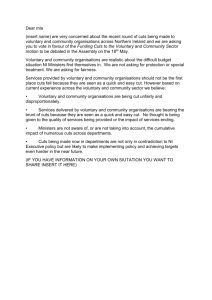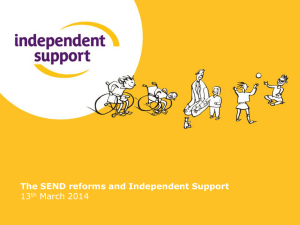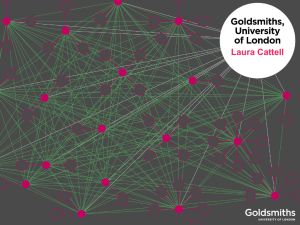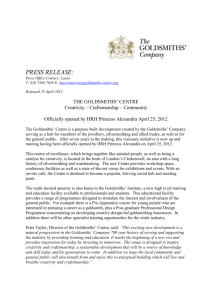What is to be Done? Universities and the voluntary and community
advertisement
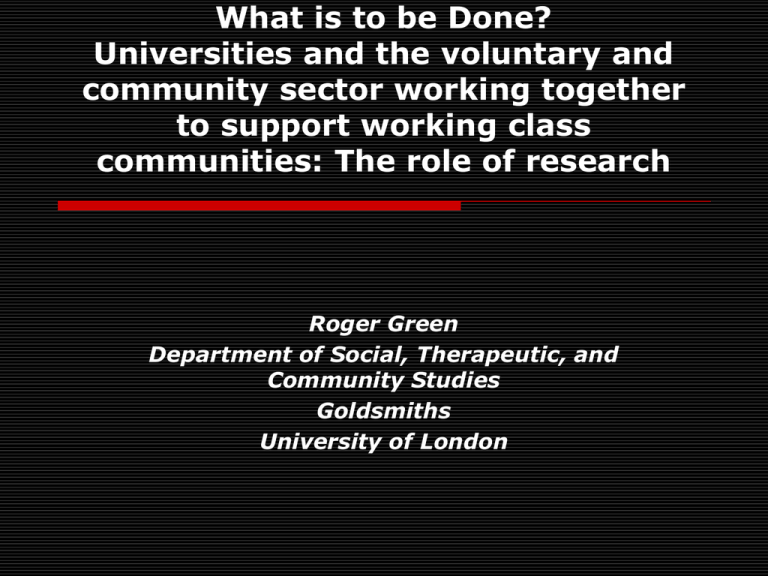
What is to be Done? Universities and the voluntary and community sector working together to support working class communities: The role of research Roger Green Department of Social, Therapeutic, and Community Studies Goldsmiths University of London The Context The Context Cheers And………….. David Harvey in his book ‘The Enigma of Capital and the Crises of Capitalism Noted that the capitalist system experiences regular implosions whereby working class communities are decimated and people are often in danger of losing everything. The Reality? the reality is the Coalition governments austerity programme that is witnessing local authorities up and down the country in financial meltdown local services experiencing massive cuts to services voluntary and community sector facing the choice of either becoming business facing social enterprises or going out of business! A question? So what is the role of the university in supporting the voluntary and community sector, their staff, and the communities they work with during yet another crisis of capitalism? Do universities have a role in the communities they are located? Universities – are communities. They employ local people. Universities are physical resources located in communities. Universities operate within specific social, economic and political community contexts. Universities have both a social and community value over and beyond their economic value. Universities are part of Civil Society. Students….and some staff often and learn live locally. An example: Goldsmiths, University of London Located in New Cross, London Borough of Lewisham. Lewisham and surrounding boroughs have some of the highest levels of social & economic deprivation. Long tradition of working and researching with local communities. Commitment to social justice; engaging with political and social realities; supporting social change; informing and shaping social policies. Many of its courses and professional training such as community development and social work reflects this. The Research Project The research looked to understand the impact on South London’s voluntary and community organisations and the groups and communities they work with of…… the Tory led Coalition government’s attack on the welfare state, its massive cuts in public and local government expenditure, and its general class biased economic austerity programme. The Research Report: ‘Working Together’ Engaging with London’s Voluntary and Community Sector: A Community Scoping Study Email me for a copy: r.green@gold.ac.uk Aims of the Study 1. To undertake a community based scoping project across South London looking at what were the current concerns, issues and needs of voluntary and community sector organisations. 2. To understand to what extent recent policies and changes in funding, have impacted on these organisations. 3. To consider how the Department of Social and Therapeutic Studies at Goldsmiths could respond. 4. To what extent was Goldsmiths currently engaged with its surrounding communities. How we did it!.....A participatory research methodology “Do not monopolize your knowledge nor impose arrogantly your techniques but respect and combine your skills with the knowledge of the researched or grassroots communities, taking them as full partners and coresearchers…” (Fals-Borda, 1995) The methodology: Research with the Community Participatory action research approach. Focus of the research was equally determined by the research participants. ‘Community walkabout’ around South London. Interviews took place with staff, trustees, volunteers and service users from 103 organisations across the South London boroughs. Attendance at community forums and meetings. Street conversations with 62 members of the public. informal discussions with over 50 Goldsmiths staff, students and their representatives. A Few Key Findings Some of the Key Findings 1 Organisations being affected disproportionately by the worsening financial climate, and the speed and scale of cuts in public expenditure. Cuts in local authority funding support - staff redundancies, reduced services and projects closing. Much less reliance on traditional sources of funding. Move from ‘grant dependency models’ to ‘entrepreneurial business models’. Expected to become business facing and/or social enterprises. Increased community demand for services, rising costs. Community needs increasing. Organisations under the threat of losing their premises or being required to pay market rents. Some of the Key Findings 2 Organisations working with minority groups felt discriminated against. Organisations continually require new evidence - information and data – to support funding bids. Wide range of research support needed by most organisations. Negative view of Coalition government’s ’Big Society’ concept/policy and Localism agenda. Majority of community organisations had little or no contact with Goldsmiths. The need for research support The need for research support Majority of community organisations had only a small number of paid staff and relied heavily on volunteers. A result of this is that they do not have the necessary in-house research capacity, research skills, and resources or access to research training. Often they are not aware of existing research findings in their area of service provision. This results in a wide range of challenges organisations including: 1. 2. 3. 4. 5. Inadequate monitoring of their service (s) and projects lacking robust evaluation. Lack of clarity as to contractual targets/outputs being met. Services promoting inclusiveness but not undertaking any real monitoring of users. Unmet community needs not being recorded. Funding applications not supported by research evidence resulting in unsuccessful applications for continuation or new funding Research skills deficit. 6. The Community event Aim of building greater university and community engagement Attended by representatives from across South London’s voluntary and community sector, and Goldsmiths staff. Ideas from the Community Event The community and voluntary sector and Goldsmiths to work more closely with each other. Research activity, support and collaboration should be the focus of this collaborative partnership. A research centre based at Goldsmiths should be the driver of this. A stakeholder group meeting to meet to progress the idea of a research centre. Outcomes A new research centre based at Goldsmiths is now being established that will support the voluntary & community sector in some of South London’s most disadvantaged communities. Goldsmiths is significantly improving its general community engagement practice and policies with local voluntary and community organisations and the communities they work with. Developing community/university collaborative partnerships community access - supporting community action research projects - developing new community networks. A number of collaborative pilot community research projects initiated by voluntary and community organisations based on community needs have commenced eg. why local food banks? and rehousing the homeless. Matching student research projects to community needs has begun. Supporting Unison’s ‘Community Service Group’ work with the voluntary and community sector. Impartial Observers….Some questions for discussion? What is the role of the universities in supporting the voluntary and community sector and its staff during yet another crisis of capitalism? To what extent is the model of collaborative community and university working proposed by this paper part of the collective fight back? Do universities, social work academic staff, staff from other academic subject disciplines, social workers, students, do what the American sociologist Howard Becker once stated and decide….. “Whose side are we on?”
